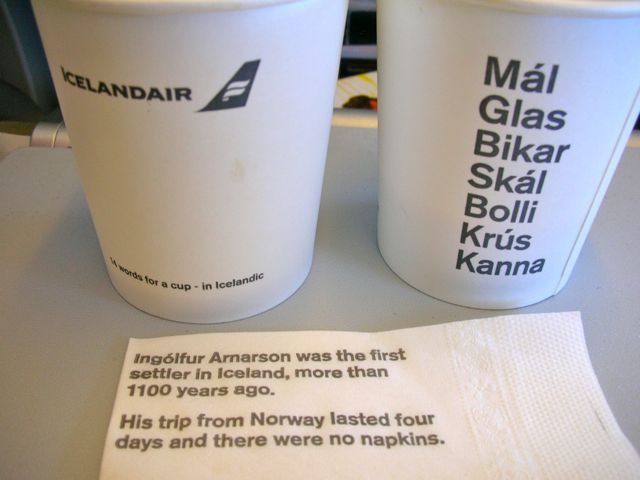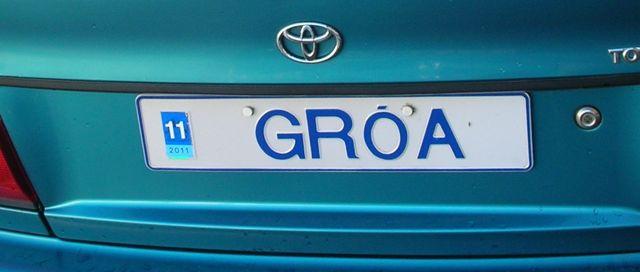Ísland: Iceland
Population: around 313,000
For the traveller to Iceland, the first sign of clever marketing of Íslenska (we speak English but think about what else we speak!) is in the Icelandair aeroplane, in which Icelandic is used for
- announcements
- briefing cards
- on the seat antimacassars, Icelandic phrases and commentary e.g. on the ‘soft and cuddly sound’ of Góða nótt ‘good night’ [check the cuddly claim here].
- and on the paper cups, 14 words for drinking vessels

[ Photo courtesy of David Nash]
Surely the smallest language group to have its own airline.
In Reykjavík, there are plenty of signs of belief in the power of writing. Despite its location on the route between several big English-speaking countries, it has managed to resist much of the pressure to advertise in English and have signs in English. For print-addicts, the city language-scape is a treasure-house – vocabulary is reinforced by seeing words in other languages in signs and notices both public (roads, schools, monuments) and private (shop and business names and windows, advertisements, churches, graveyards). And hey! vanity plates using Icelandic diacritics [Gróa was a witch healer in Norse mythology].

[ Photo courtesy of David Nash]
Cyber-space is also sparkling with .is pages in Icelandic for enterprises, commerical, public and sociable – even the knit cafes get mentioned.. (see Handprjónasamband Íslands (the Hand-knitting association of Iceland). BUT the website for the parent airline group appears in English and doesn’t advertise an Icelandic alternative. Uhuh. Commercial decisions are probably the coal-mine canaries for language health.
We went into several bookshops (Eymundsson and Mál og Menning) with cafés. It is impressive how much is written in Icelandic, and how much is translated (check out Forlagið). It’s wide-ranging – from Richard Dawkins on God (a big display) to translations of Finn Family Moomintroll, Astrid Lindgren and Harry Potter, to Bill Bryson, to a whole heap of airport reads (John Grisham, Jodie Picoult, Charlaine Harris). All this with a small population, and having to import paper.
All of this must be helping standardise ways of talking about new ideas, so expanding the domains in which it is easy to talk Icelandic. The Berlitz guidebook to Reykjavík shamed its parent company by sniffily commenting on the Icelanders’ ‘pedantic’ habit of compounding Icelandic roots to form words for new concepts. But does that reflect the views of outsiders complaining about Icelanders not using loanwords, or the frustration of some at the language purism of others? Anyway I am sorry now that I didn’t check how ‘vampire’ was translated, let alone ‘true blood’.
 Follow
Follow